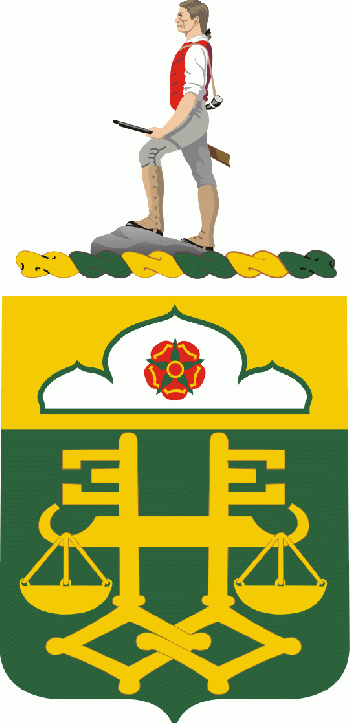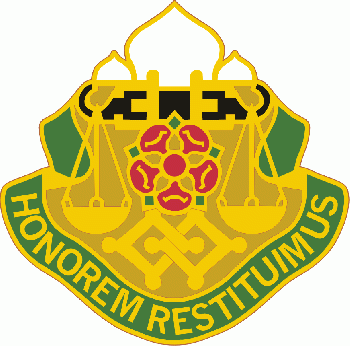160th Military Police Battalion, US Army: Difference between revisions
Knorrepoes (talk | contribs) m (Text replacement - "{{media}}↵" to "") |
Knorrepoes (talk | contribs) m (Text replacement - ": " to ":") Tags: Mobile edit Mobile web edit |
||
| (7 intermediate revisions by 2 users not shown) | |||
| Line 1: | Line 1: | ||
''' {{uc:{{PAGENAME}}}} ''' | ''' {{uc:{{PAGENAME}}}} ''' | ||
{|align="center" | {|align="center" | ||
|align="center"|[[File:160mpa.gif|center|350 px| | |align="center"|[[File:160mpa.gif|center|350 px|Coat of arms (crest) of {{PAGENAME}}]] <br> (Coat of Arms) | ||
|align="center"|[[File:160mpb.gif|center|350 px| | |align="center"|[[File:160mpb.gif|center|350 px|Coat of arms (crest) of {{PAGENAME}}]] <br> (Distinctive Unit Insignia) | ||
|} | |} | ||
| Line 14: | Line 12: | ||
===Official blazon=== | ===Official blazon=== | ||
Shield: Vert, two keys palewise wards to chief addorsed with bows braced surmounted by a balance beam pendant of two pans Or, on a chief of the like the domes of Taj Mahal couped Argent, fimbriated of the first, charged with a heraldic rose Gules <br> | Shield:Vert, two keys palewise wards to chief addorsed with bows braced surmounted by a balance beam pendant of two pans Or, on a chief of the like the domes of Taj Mahal couped Argent, fimbriated of the first, charged with a heraldic rose Gules <br> | ||
Crest: That for regiments and separate battalions of the Army Reserve: From a wreath Or and vert, the Lexington Minute Man Proper. The Statue of the Minute Man, Captain John Parker (H.H. Kitson, sculptor) stands on the common in Lexington, Massachusetts<br> | Crest:That for regiments and separate battalions of the Army Reserve:From a wreath Or and vert, the Lexington Minute Man Proper. The Statue of the Minute Man, Captain John Parker (H.H. Kitson, sculptor) stands on the common in Lexington, Massachusetts<br> | ||
Motto: Honorem restituimus (We restore honor). | Motto:Honorem restituimus (We restore honor). | ||
Distinctive Unit Insignia, Description: A gold color metal and enamel device 1 1/8 inches (2.86 cm) in height overall consisting of two erect gold keys addorsed and conjoined at the bows and surmounted at the center of the shanks by a red heraldic rose all in front of an between a pair of scales, the balance beam black and the scale pans gold and issuing above the balance beam a tapered white dome between the tops of two smaller domes (a representation of the Taj Mahal) all above agreen scroll, the ends curving inward behind the pendant supports the scale pans inscribed "HONOREM RESTITUIMUS" in gold letters. | Distinctive Unit Insignia, Description:A gold color metal and enamel device 1 1/8 inches (2.86 cm) in height overall consisting of two erect gold keys addorsed and conjoined at the bows and surmounted at the center of the shanks by a red heraldic rose all in front of an between a pair of scales, the balance beam black and the scale pans gold and issuing above the balance beam a tapered white dome between the tops of two smaller domes (a representation of the Taj Mahal) all above agreen scroll, the ends curving inward behind the pendant supports the scale pans inscribed "HONOREM RESTITUIMUS" in gold letters. | ||
===Origin/meaning=== | ===Origin/meaning=== | ||
Green and yellow are the colors used for Military Police. The two keys denote custody and restoration and, together with the scales of justice symbolize the organization's basic mission in the rehabilitation of military offenders. The rose alludes to the unit's sepecial award for outstanding devotion to duty. The Taj Mahal refers to the unit's service in India during World War II. | Green and yellow are the colors used for Military Police. The two keys denote custody and restoration and, together with the scales of justice symbolize the organization's basic mission in the rehabilitation of military offenders. The rose alludes to the unit's sepecial award for outstanding devotion to duty. The Taj Mahal refers to the unit's service in India during World War II. | ||
The | The arms were approved on 12 June 1996. The Distinctive Unit Insignia was approved on 21 January 1971. | ||
[[Literature]]:The Institute of Heraldry, US Army. | |||
{{us}} | |||
{{media}} | |||
[[Category:Military heraldry of the United States]] | [[Category:Military heraldry of the United States]] | ||
[[Category: Army heraldry]] | [[Category:Army heraldry]] | ||
[[Category: Granted 1971]] | [[Category:Granted 1971]] | ||
[[Category: Granted 1996]] | [[Category:Granted 1996]] | ||
Latest revision as of 06:58, 24 July 2024
160TH MILITARY POLICE BATTALION, US ARMY
| (Coat of Arms) |
(Distinctive Unit Insignia) |
Official blazon
Shield:Vert, two keys palewise wards to chief addorsed with bows braced surmounted by a balance beam pendant of two pans Or, on a chief of the like the domes of Taj Mahal couped Argent, fimbriated of the first, charged with a heraldic rose Gules
Crest:That for regiments and separate battalions of the Army Reserve:From a wreath Or and vert, the Lexington Minute Man Proper. The Statue of the Minute Man, Captain John Parker (H.H. Kitson, sculptor) stands on the common in Lexington, Massachusetts
Motto:Honorem restituimus (We restore honor).
Distinctive Unit Insignia, Description:A gold color metal and enamel device 1 1/8 inches (2.86 cm) in height overall consisting of two erect gold keys addorsed and conjoined at the bows and surmounted at the center of the shanks by a red heraldic rose all in front of an between a pair of scales, the balance beam black and the scale pans gold and issuing above the balance beam a tapered white dome between the tops of two smaller domes (a representation of the Taj Mahal) all above agreen scroll, the ends curving inward behind the pendant supports the scale pans inscribed "HONOREM RESTITUIMUS" in gold letters.
Origin/meaning
Green and yellow are the colors used for Military Police. The two keys denote custody and restoration and, together with the scales of justice symbolize the organization's basic mission in the rehabilitation of military offenders. The rose alludes to the unit's sepecial award for outstanding devotion to duty. The Taj Mahal refers to the unit's service in India during World War II.
The arms were approved on 12 June 1996. The Distinctive Unit Insignia was approved on 21 January 1971.
Literature:The Institute of Heraldry, US Army.
US heraldry portal
This page is part of the US heraldry portal |
Heraldry of the World |
|
US heraldry:
|
Ecclesiastical Heraldry of the USA:
Military Heraldry: |
Contact and Support
Partners:
Your logo here ?
Contact us
© since 1995, Heraldry of the World, Ralf Hartemink 
Index of the site
















